
The Solar-Terrestrial Centre of Excellence (STCE) is a collaborative network of the Belgian Institute for Space Aeronomy, the Royal Observatory of Belgium and the Royal Meteorological Institute of Belgium.
 |
Published by the STCE - this issue : 5 Mar 2015. The Solar-Terrestrial Centre of Excellence (STCE) is a collaborative network of the Belgian Institute for Space Aeronomy, the Royal Observatory of Belgium and the Royal Meteorological Institute of Belgium. |
| Archive of the newsletters | Subscribe to this newsletter by mail |
On 24 February 2015, around 10:00UT, the Sun put on quite a show with a gorgeous filament eruption. PROBA2 was on the outlook, and its EUV camera (SWAP) recorded a magnificent movie of the event (see http://proba2.oma.be/swap/data/mpg/movies/campaign_movies/2015_02_24/ ).
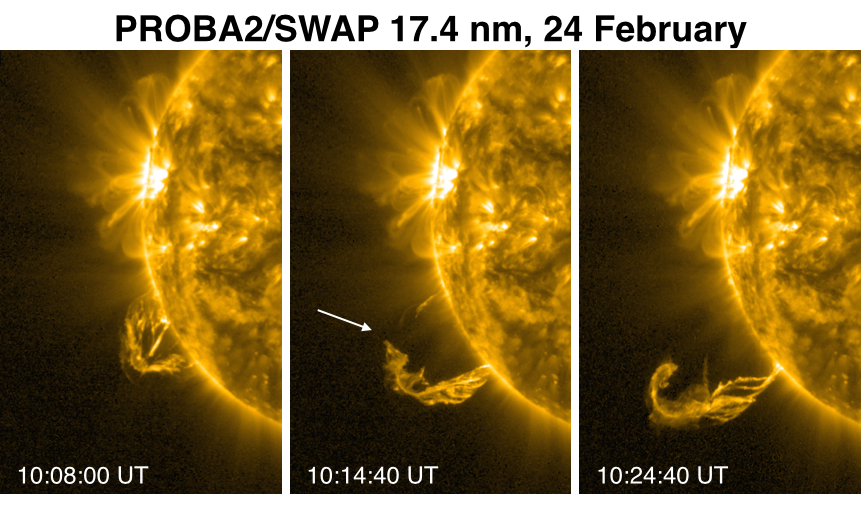
Filaments are clouds of plasma which are suspended in the corona, but they are denser and cooler than the surrounding coronal plasma. This plasma is trapped in dips in the magnetic field, such that it can not flow back down to the chromosphere (the inner atmosphere of the Sun). Filaments generally occur above photospheric neutral lines, which are the dividing line between magnetic fields that are directed into (negative, "black") and out (positive, "white") of the surface of the Sun, as can be seen in the sketch underneath. Filaments can be very long, as reported in previous news items (such as http://stce.be/news/294/welcome.html), or they can be smaller. Most of the shorter ones occur within active regions. In the images below, from the day of the eruption, you can see both long and short filaments. But you can't see the filament that erupted, because at the time these images were taken it had already erupted!
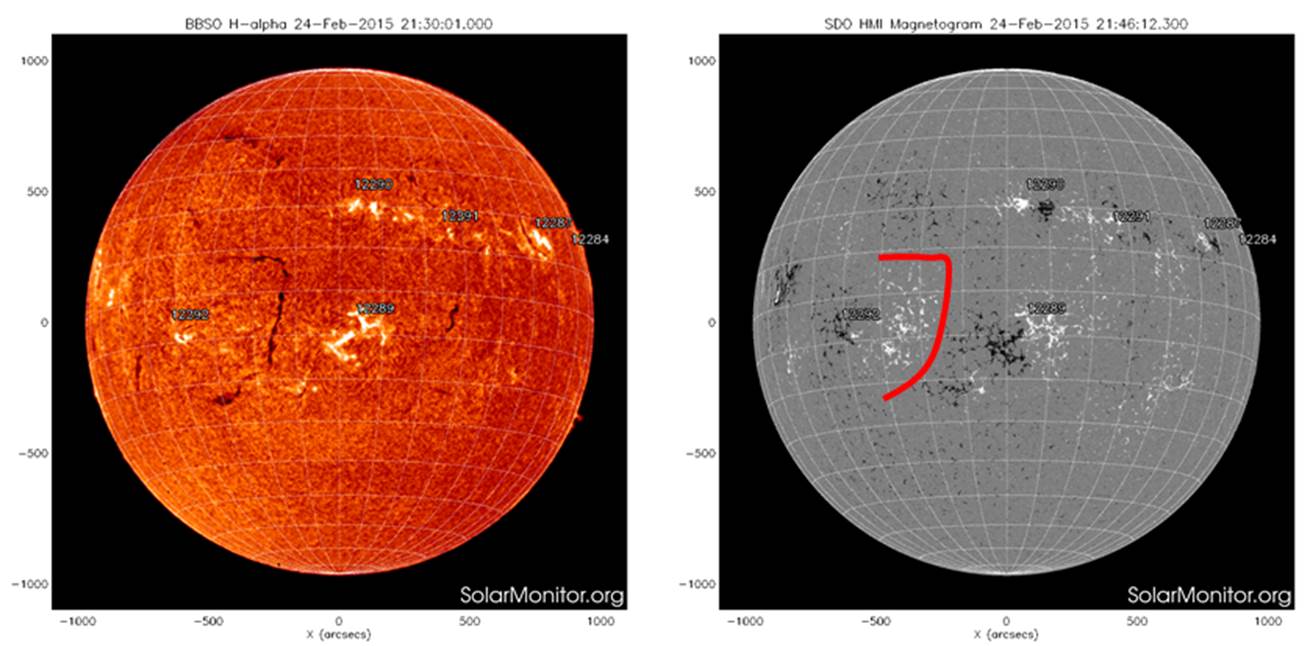
The eruption that you can see in the movie looks like it begins slightly behind the limb of the Sun, so that from the point of view of Earth we might not be seeing the whole original filament. Unfortunately, the STEREO spacecraft are currently in hibernation on the far side of the Sun, so we don't have any more information about the 3D nature of this eruption. But we can clearly see the filament material rise into the solar atmosphere during the eruption.
In the early stages of this eruption, the filament roughly traces a large loop that is expanding. As it expands, the leg closest to the equator appears to "break", as indicated in the top middle image. The filament plasma is a tracer of the magnetic field, it is not showing us the whole picture. While it is possible that there is a magnetic reconnection event where the filament plasma separates, it is not the only explanation. In this case the field might very well be continuously expanding with no abrupt topological changes at that stage.
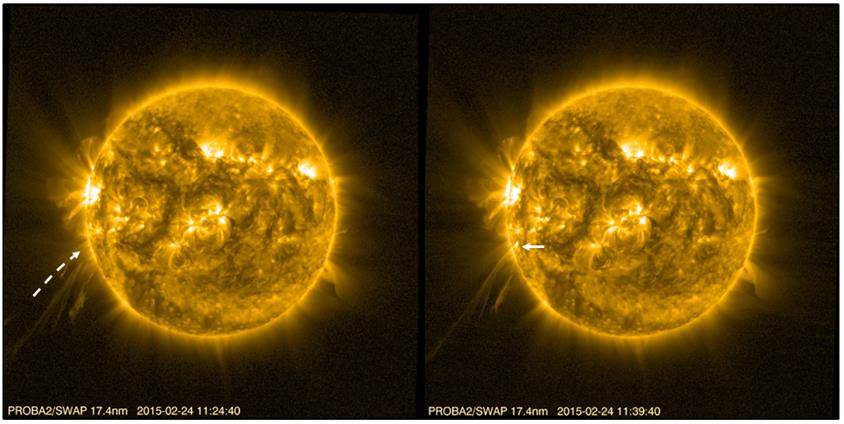
Later in the event, some of the filament material is seen to fall back down to the surface of the Sun (see image above on the left). These parcels of filament material are trapped on dips in the magnetic field. When the field expands during the eruption, some of the field stretches and the dips disappear. If a magnetic flux tube straightens out, but remains connected to the Sun, the plasma on that tube may slide back to the Sun, and this is what we see in the movie. The filament plasma then causes localized brightenings where it hits the surface, as indicated by an arrow in the image above on the right.
Behind these localized brightenings, bright loops form rapidly near the former location of the filament footpoint shortly after 12:00UT. These loops are known as post eruptive loops, and they are a common signature of reconnection. See the news items at http://stce.be/news/274/welcome.html (21 October 2014) and http://stce.be/news/291/welcome.html (22 January 2015) for more examples of post eruptive loops.
By looking at SOHO's coronagraphic imagery, however, we do know that this filament eruption caused a gorgeous coronal mass ejection (CME). Unfortunately for us, the direction of the CME is almost perfectly aligned with the support post of the disk that hides the detector from direct sunlight.
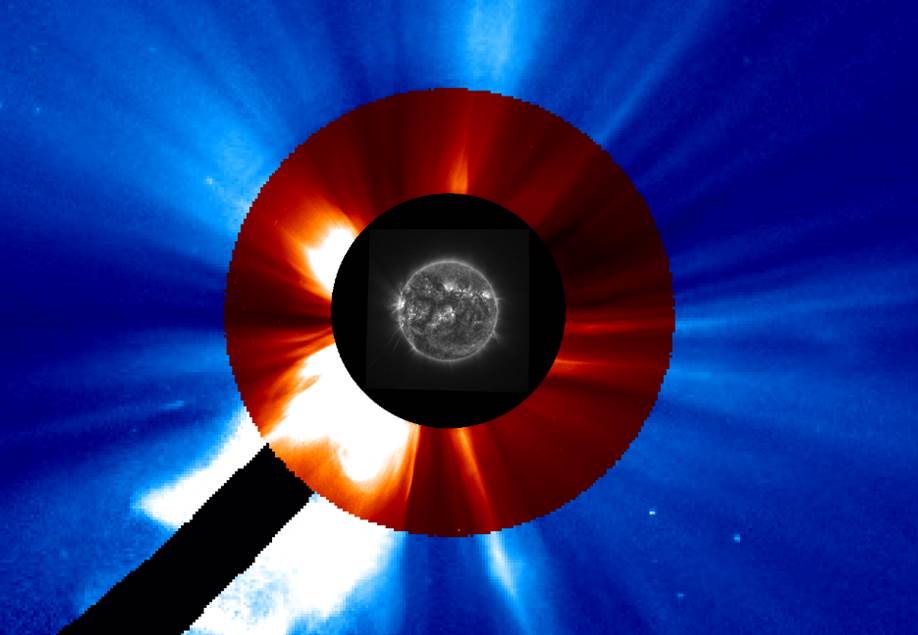
This article was written by the PROBA2 Team. If you have any questions, you can contact them at swap_lyra@oma.be
Solar activity was very low until 28 February when active region NOAA 2294 obtained a beta-gamma configuration and started producing C-class flares, together with NOAA 2290. The strongest one was a C6.8 peaking at 16:13UT on 01 March from NOAA 2290. The figures underneath show the overall flare evolution during the week, and NOAA 2290 (left), the C6 flare (middle) and the post-flare coronal loops (right).
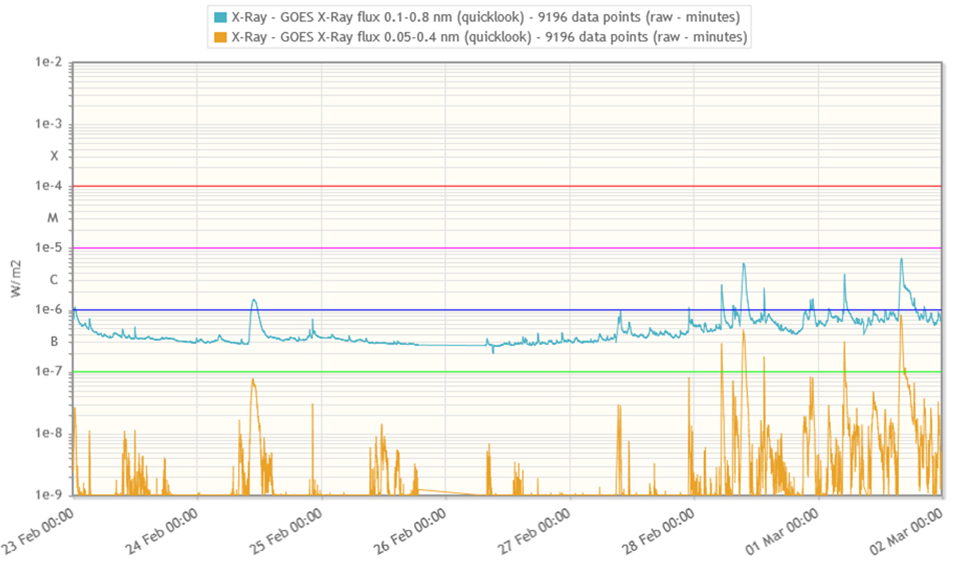

There were four strong backsided coronal mass ejections (CMEs; depicted below): on 24 February at 10:24UT (partial halo); on 28 February at 04:36UT (halo) and at 21:36UT (halo); and on 01 March at 12:36UT (almost full halo).
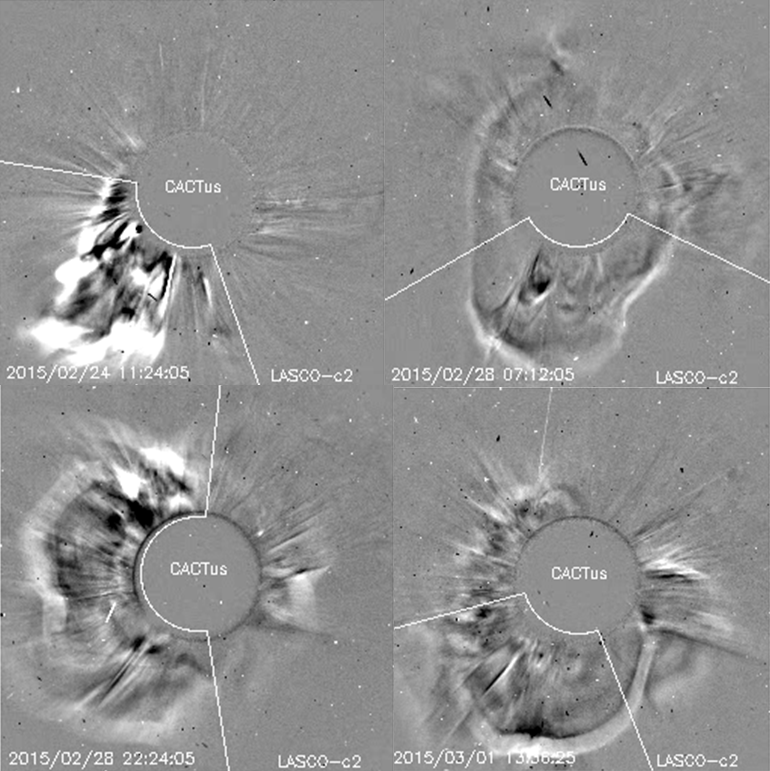
On 24 February, there were also two slow CMEs (at 13:36UT with +/-300 km/s, and at 23:24UT with +/-200 km/s), with slight chances of an Earth encounter by 01 March. No important geomagnetic consequences were expected, due to the low speeds. Another slow CME (about 300 km/s) was seen erupting on 28 February at 15:12UT with possible arrival by 04 March, but also in this case the CME was not expected to produce more than active periods.
Solar flare activity fluctuated between quiet and low during the week.
In order to view the activity of this week in more detail, we suggest to go to the following website from which all the daily (normal and difference) movies can be accessed:
http://proba2.oma.be/ssa
This page also lists the recorded flaring events.
A weekly overview movie can be found here (SWAP week 257).
http://proba2.oma.be/swap/data/mpg/movies/weekly_movies/weekly_movie_2015_02_23.mp4
Details about some of this week's events, can be found further below.
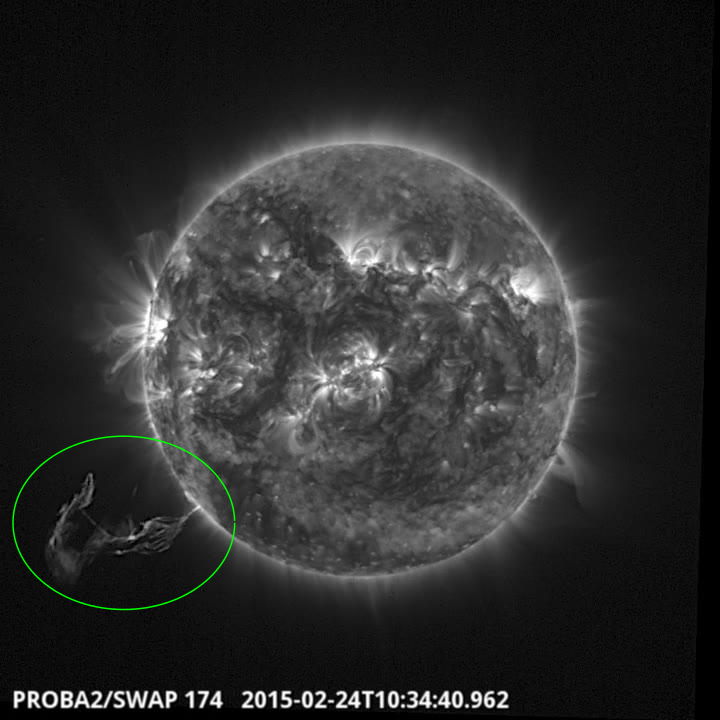
Eruption on south east limb @ 10:34 SWAP image
Find a movie of the event here (SWAP movie)
http://proba2.oma.be/swap/data/mpg/movies/2015/02/20150224_swap_movie.mp4
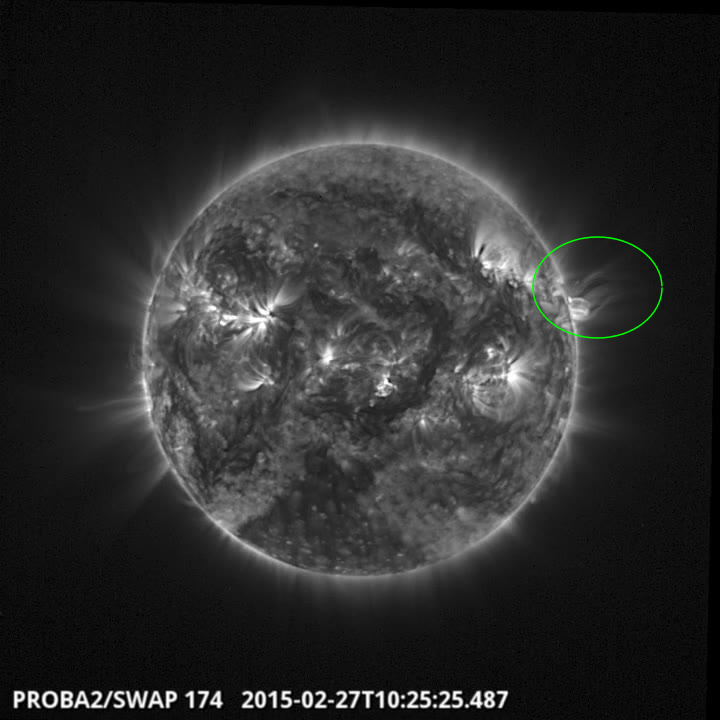
Eruption on the west limb @ 10:25 SWAP image
Find a movie of the event here (SWAP movie)
http://proba2.oma.be/swap/data/mpg/movies/2015/02/20150227_swap_movie.mp4
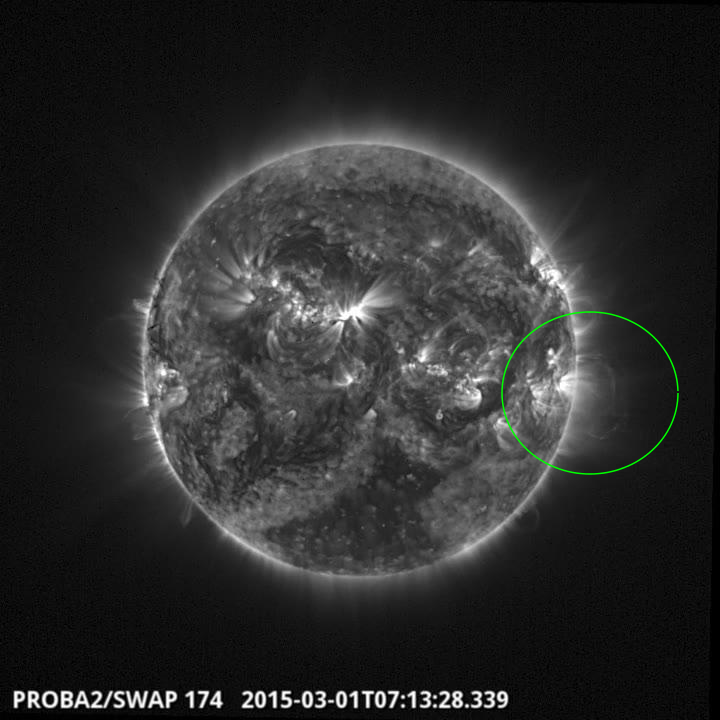
Eruption on the west limb @ 13:28 SWAP image
Find a movie of the event here (SWAP movie)
http://proba2.oma.be/swap/data/mpg/movies/20150301_swap_movie.mp4
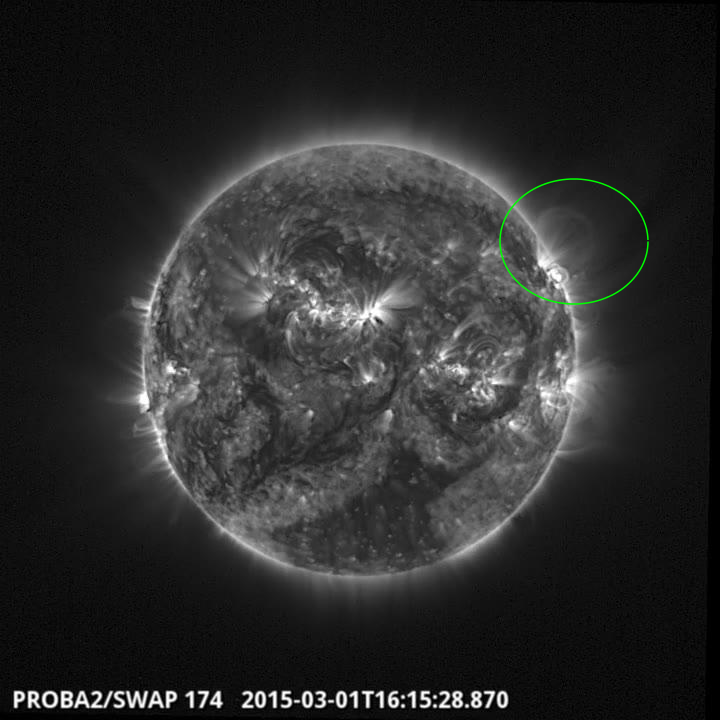
Eruption on the north west limb @ 16:15 SWAP image
Find a movie of the event here (SWAP movie)
http://proba2.oma.be/swap/data/mpg/movies/20150301_swap_movie.mp4
There were two fast speed streams affecting the Earth. One started on 23 February and caused active conditions in Dourbes and minor storm conditions globally (Kp) on February 24. The second stream arrived at the Earth on 28 February and caused minor storm conditions at local and planetary levels on 01 March. None of the aforementioned CMEs arrived at Earth.
The graphs underneath show the density (blue) of the solar wind, its speed (orange), and temperature (grayish).
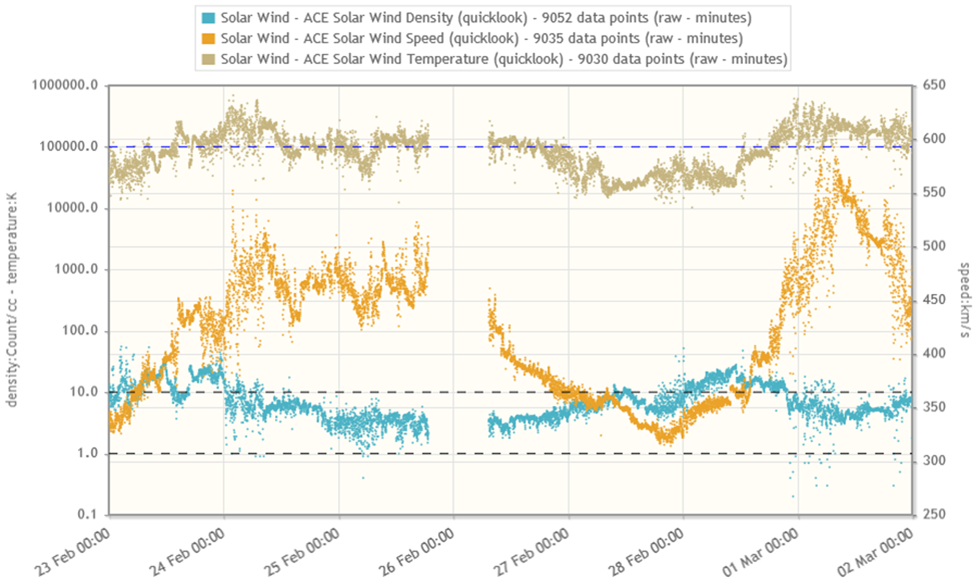
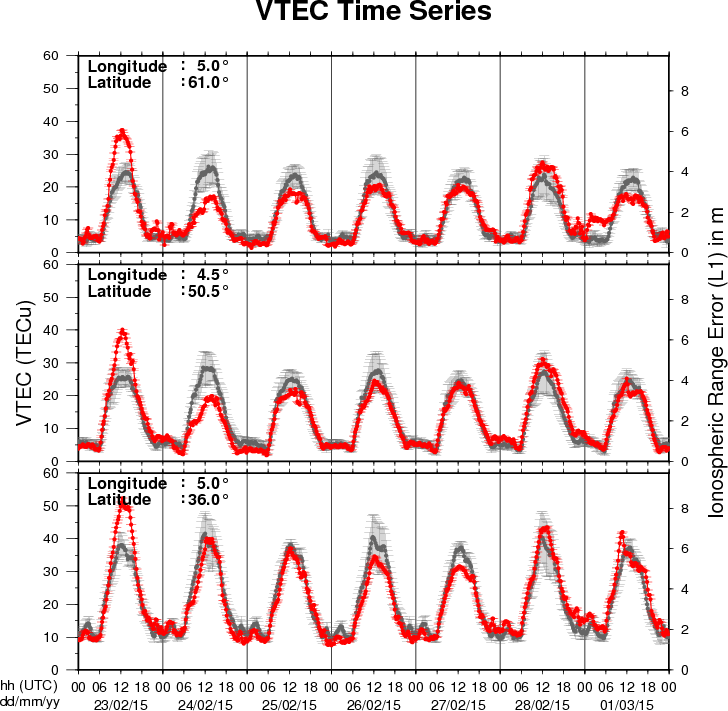
The figure shows the time evolution of the Vertical Total Electron Content (VTEC) (in red) during the last week at three locations:
a) in the northern part of Europe(N61°, 5°E)
b) above Brussels(N50.5°, 4.5°E)
c) in the southern part of Europe(N36°, 5°E)
This figure also shows (in grey) the normal ionospheric behaviour expected based on the median VTEC from the 15 previous days.
The VTEC is expressed in TECu (with TECu=10^16 electrons per square meter) and is directly related to the signal propagation delay due to the ionosphere (in figure: delay on GPS L1 frequency).
The Sun's radiation ionizes the Earth's upper atmosphere, the ionosphere, located from about 60km to 1000km above the Earth's surface.The ionization process in the ionosphere produces ions and free electrons. These electrons perturb the propagation of the GNSS (Global Navigation Satellite System) signals by inducing a so-called ionospheric delay.
See http://stce.be/newsletter/GNSS_final.pdf for some more explanations ; for detailed information, see http://gnss.be/ionosphere_tutorial.php
Start : 2015-03-16 - End : 2015-03-19
This international conference will provide an overview of our
current understanding of Sun-Climate Connections starting at
processes on the Sun itself over space weather and solar wind
towards solar influence on the upper atmosphere down to the ocean.
It will also provide insights into the heatedly debated role of the
Sun in climate change. In four sessions the various contributions
of solar variability influence on Earth's climate will be presented
and discussed by bringing together solar physicists, space
scientists, atmospheric scientists, climate modellers, and
paleoclimatologists.
We expect contributions from scientists participating in
SCOSTEP/ROSMIC, SPARC-SOLARIS/HEPPA, the EU cost network TOSCA, as
well as any other interested scientists. The conference will last
three full days, beginning Monday morning, 16 March 2013. The
programme will consist of invited and keynote lectures, a few
contributed oral presentations and ample time dedicated to poster
sessions. The fourth day will be devoted to public outreach
activities as well as panel discussions.
Website: http://scc.geomar.de/
Start : 2015-05-18 - End : 2015-05-22
URSI AT-RASC 2015 will be the first edition of the newly
established triennial URSI Atlantic Radio Science Conference as one
of the URSI Flagship Conferences. AT-RASC 2015 will have an open
scientific program composed of submitted papers within the domains
covered by all ten Commissions of URSI.
Website: http://www.at-rasc.com/
Start : 2015-05-25 - End : 2015-05-29
25-27 May 2015: BUKS 2015 - MHD waves: Observational aspects
from ground to space - MHD waves: Theory - where are we? - MHD
instabilities
27-28 May 2015: Ruderman Honorary meeting - Theory of linear MHD
waves - MHD waves instabilities - Non-linear waves in plasmas
29 May 2015: Joint BUKS/Ruderman's conferences excursion -
Boat excursion to Szentendre, Visegrad and Esztergom
Website:
http://swat.group.shef.ac.uk/Conferences/BUKS_2015/index.html
Start : 2015-06-01 - End : 2015-07-24
The Space Weather Summer School at Los Alamos National
Laboratory, established in 2011 under the founding Director Josef
Koller, is dedicated to space weather, space science and
applications. Every year we solicit applications for the Los Alamos
Space Weather Summer School. This summer school is sponsored and
supported by a number or organizations at LANL. This year our top
sponsors include the Los Alamos Institute of Geophysics, Planetary
Physics and Signatures (IGPPS) and the Laboratory Directed Research
and Development Office (LDRD). The summer school brings together
top space science students with internationally recognized
researchers at LANL in an educational and collaborative
atmosphere.
Website:
http://www.swx-school.lanl.gov/
Start : 2015-06-09 - End : 2015-06-12
The last five years have seen substantial progress in our
understanding of the solar dynamo, fueled by continuing advances in
observations and modeling. With the launch of NASA's Solar Dynamics
Observatory (SDO) in 2010 came an unprecedented window on the
evolving magnetic topology of the Sun, highlighting its intricate
3D structure and global connectivity. The Helioseismic Magnetic
Imager (HMI) instrument on SDO in particular has provided
potentially transformative yet enigmatic insights into the internal
dynamics of the solar convection zone that underlie the dynamo.
Attempts to detect subsurface convective motions from helioseismic
inversions have yielded only upper limits on the large-scale
convective amplitude, challenging our understanding of global solar
convection. Yet, potential signatures of giant cells have been
detected in photospheric Dopplergrams. Estimates of the meridional
flow from HMI and complementary instruments (SOHO/MDI and GONG)
have been equally tantalizing and enigmatic. Several disparate
techniques, including local and global helioseismic inversions and
correlation tracking of surface features, have yielded evidence of
a multi-cellular meridional flow but they differ on the detailed
flow structure and amplitude. This multi-cellular meridional flow
has potentially profound implications for flux-transport dynamo
models that previously assumed a very different structure with a
single circulation cell per hemisphere.
Website:
https://www2.hao.ucar.edu/Workshop/Solar-Dynamo-Frontiers
Start : 2015-07-13 - End : 2015-07-24
The CISM Summer School is intended to give students a
comprehensive immersion in the subject of space weather: what it
is, what it does, and what can be done about it. Space weather is
many things: beautiful when seen through the eyes of a sun-viewing
telescope, fascinating when studied for its alien worlds of
magnetic structures and phenomena, awesome when witnessed as a
solar eruption or auroral storm, and devastating to the users of
services it disrupts. Space weather links the Sun, the Earth, and
the space in between in a branching chain of consequences. Weather
systems on the Sun can spawn interplanetary storms of colossal size
and energy that envelop the whole planet in electrical hurricanes.
Such storms attack high-tech, complex, and expensive technological
systems that provide much of the infrastructure that allows modern
society to function.
Website:
https://www2.hao.ucar.edu/Events/2015-CISM-Summer-School
Start : 2015-07-21 - End : 2015-07-23
The conference will review past and recent achievements, as well
as future challenges in the field of solar coronal loop
physics.
Website:
http://www.damtp.cam.ac.uk/user/astro/cl7/index.html
Start : 2015-07-28 - End : 2015-08-04
Heliophysics is all of the science common to the field of the
Sun-Earth connections. This fast-developing field of research
covers many traditional sub-disciplines of space physics,
astrophysics, and climate studies. The NASA Living with a Star
program, with its focus on the basic science underlying all aspects
of space weather, acts as a catalyst to bring the many research
disciplines together to deepen our understanding of the system of
systems formed by the Sun-Earth connection.
Website:
http://www.heliophysics.ucar.edu/
Start : 2015-07-30 - End : 2015-08-06
The 34th International Cosmic Ray Conference (ICRC) will be held
from July 30 to August 6, 2015, in The Hague, The Netherlands. It
is an important and large conference in the field of Astroparticle
Physics. The ICRC covers: cosmic-ray physics, solar and
heliospheric physics, gamma-ray astronomy, neutrino astronomy, and
dark matter physics.
Website: http://icrc2015.nl
Start : 2015-08-31 - End : 2015-09-04
The purpose of this conference is to discuss the latest
questions and results in solar and stellar physics. Solar and
stellar seismology will be one particular focus but contributions
on all aspects of solar-stellar relations will be welcome. We aim
to establish links and synergies between the day- and night-time
fields of astrophysics.
Website:
http://www.iac.es/congreso/solarnet-3meeting/
Start : 2015-09-02 - End : 2015-09-04
The Workshop will address how the joint exploration of the
corona and inner heliosphere will lead to advances in our
understanding of coronal heating and solar wind acceleration, the
magnetic and plasma structure of the heliosphere, and the
acceleration of energetic particles at shocks and flares. The
workshop will inspire research that will make use of SO and SPP
observations within the context of the NASA Heliophysics
Observatory System and identify key areas for preparatory research.
Synergistic observations from other ground based and space based
assets will also be addressed.
Website:
http://www.solarprobeplus.org/2015/
Start : 2015-10-05 - End : 2015-10-09
This CSPM-2015 scientific meeting will cover various aspects of
solar dynamic and magnetic phenomena which are observed over the
entire electromagnetic spectrum: white-light, Hα, Ca II,
and radio from ground and in a variety of other wavelengths (white
light, UV and EUV, and X-rays) from space. Emphasis will also be
placed on instrumentation, observing techniques, and solar image
processing techniques, as well as theory and modelling through
detailed radiative transfer in increasingly realistic MHD models.
The long-term (cyclic) evolution of solar magnetism and its
consequence for the solar atmosphere, eruptive phenomena, solar
irradiation variations, and space weather, will be in focus. Here,
special attention will be devoted to the long-term observations
made in Coimbra and also to the results of the SPRING / SOLARNET
and SCOSTEP VarSITI studies. In particular, the weak solar activity
during the current solar maximum will be discussed. Finally, since
this meeting is organised around the 90th anniversary of performing
the first spectroheliographic observations in Coimbra, a session
will be specially dedicated to new solar instruments (both
ground-based and space-borne) that will give access to unexplored
solar atmospheric features and dynamic phenomena over the coming
years.
Website:
http://www.mat.uc.pt/~cspm2015/
Start : 2015-11-10 - End : 2015-11-13
Observations of the Sun and Earth from space have revolutionized
our view and understanding about impacts of solar variability and
anthropogenic forcing on Earth climate. For more than three solar
cycles since 1978, the total and spectral solar irradiance (TSI and
SSI) and global terrestrial atmosphere/surface have been observed
continuously, enabling unprecedented quality data for Sun-climate
studies. The primary objective of this symposium is to convene
climate scientists, solar physicists, and experimentalists together
for a better understanding how Earth climate system changes and
responds to solar variability.
Website:
http://lasp.colorado.edu/home/sorce/news-events/meetings/2015-sun-climate-symposium/
Start : 2016-07-30 - End : 2016-08-07
The 41st COSPAR Scientific Assembly will be held in Istanbul,
Turkey from 30 July - 7 August 2016. This Assembly is open to all
bona fide scientists.
Website:
https://www.cospar-assembly.org/
Theoretical course on the Sun and space weather for participants to the astronomy course in Public Observatory MIRA, Grimbergen (Belgium). Given on 19 March 2014 for 35 attendees.
http://www.spaceweather.eu/en/repository/show?id=557
Presentation given during a users' visit about the STCE operational space weather services and products.
http://www.spaceweather.eu/en/repository/show?id=558
Presentation given during a users' visit about the STCE operational space weather services and products.
http://www.spaceweather.eu/en/repository/show?id=559
Presentation given during a users' visit about the STCE operational space weather services and products.
http://www.spaceweather.eu/en/repository/show?id=560
Presentation given during a users' visit about the STCE operational space weather services and products.
http://www.spaceweather.eu/en/repository/show?id=561
Presentation given during a users' visit about the STCE operational space weather services and products.
http://www.spaceweather.eu/en/repository/show?id=562
Presentation given during a users' visit about the STCE operational space weather services and products.
http://www.spaceweather.eu/en/repository/show?id=563
Invited review submitted to the journal Revue E. This article is the first in a series of 3 articles.
De Zon, Helios, Sol, ... er bestaan vele namen voor die gele bol die dagelijks ons hemelgewelf doorkruist en onze warmte- en lichtbron bij uitstek is. Dankzij satellietwaarnemingen hebben we onze ster leren kennen als een dyna- misch en explosief hemelobject dat aan de basis ligt van het zogenaamde ruimteweer dat een belangrijke impact heeft op onze technologie.
http://www.spaceweather.eu/en/repository/show?id=564
On the occasion of the solar eclipse of March 20, 2015, we contributed to the March 2015 edition of the amateur astronomer journal 'Zenit'. We highlighted the outcome of LASCO onboard of SOHO and focussed on the role of the STCE on space missions like PROBA2, PROBA3 and Solar Orbiter.
The text is written in Dutch.
http://www.spaceweather.eu/en/repository/show?id=565